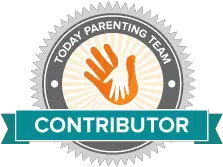FREE PREGNANCY CHALLENGE: say bye-bye to harsh chemicals & toxins.
[rank_math_breadcrumb]
Green Baby Deals is reader-supported. When you buy through links on our site, we may earn an affiliate commission. As an Amazon Associate, we earn from qualifying purchases. Learn more.
Connect with others from pregnancy through motherhood (on a free app). Join community now.
Although I try to avoid plastic as much as possible, it’s everywhere. So which plastic numbers are safe? Check out the chart (and click it for a printable version):
Recycling Numbers Reference:
♻ #1
PET or PETE (Polyethylene Terephthalate). Thin and clear — soda and water bottles, cooking oils. Never reuse, refill or heat. Repeated use increases the risk of leaching and bacterial growth. Recyclable. Safe for one use only.
♻ #2
HDPE (High-Density Polyethylene). Thick and opaque — water jugs, shampoo and detergent containers. There’s a lower risk of leaching than #1, but limit how often you refill. Recyclable.
♻ #3
V or PVC (vinyl). Rigid or flexible — bibs, teething rings, mattress covers and sandwich bags. Contains numerous toxic chemicals including lead and phthalates. Known as the “poison plastic.” Not recyclable. Avoid, avoid, avoid.
♻ #4
LDPE (low-density polyethylene). Soft and flexible — grocery store bags, plastic wrap and garbage bags. Recyclable, but typically not curbside and often dumped into landfills. Use less of these (click here to see tips below), or check where to recycle your plastic bags and wraps here.
♻ #5
PP (Polypropylene). Hard yet flexible — disposable diapers, plastic baby bottles, cups, yogurt and ice cream containers. Avoid using in the microwave and dishwasher. Recyclable.
♻ #6
PS (Polystyrene). Rigid — egg cartons, styrofoam cups, opaque plasticware. Can leach styrene, a known neurotoxin with other harmful health effects.5 Not recyclable. Avoid, avoid, avoid.
♻ #7
OTHER. Varies — baby bottles, sippy cups, 5-gallon water jugs. Any other plastic not mentioned are dumped into this category. It could include polycarbonate with potential cancer-causing BPA.6 So it’s best to avoid. Not recyclable.
Side note: all recycling programs are unique (and confusing)! Check with your local county to see what you should be doing curbside.
Also check here to see what’s recyclable in your area.
What Plastic Recycling Numbers Should I Avoid?
How in the world can you keep this straight? Remember this (kinda) simple rhyme:
7, 6 and 3: not for baby and me.
Why Should I Avoid Plastic?
Let’s face it: plastics are everywhere and can be tough to avoid.
Why avoid them? Certain plastics leach into the food and water they contain. BPA exposure has been associated with adverse neurobehavioral development, cancer, asthma, and fertility outcomes.1
As if that’s not enough, there’ve been some reports stating “BPA-free” plastic may contain even more harmful chemicals than BPA, such as BPS (bisphenol-S).2
And of course, our planet has become choked full of plastic, including a floating plastic island. 🙁
If and when you need to use them, follow these tips:
- Never microwave plastic. Ever.
- Use plastics for foods/liquids that have already been cooled down enough for your baby to eat/drink.
- Never reuse plastics intended for a single use (labeled as #1 plastic).
- Wash plastics thoroughly by hand with warm soapy water. (This will reduce wear and tear caused by the dishwasher.)
- Don’t store anything in plastic.
Plastic Alternatives
Remember, even when the plastic number is recyclable, only a small percentage ends up being recycled.
So consider the following for more sustainability:
- Lifefactory glass bottle
- Borosilicate glass food storage containers
- Food-grade silicone straws
- Sustainable food covers
- Washable produce bags
- Beeswax food wraps
- Platinum silicone reusable easy-clean sandwich bag
- Stainless steel travel mug
- Collapsible food-grade silicone container (bring it with you to replace styrofoam leftover containers at restaurants)
- Organic soap & shampoo bar
Of course sometimes you’ll pay a tad more upfront, but the savings for you (and the earth) in the long run are priceless.
See my list of natural baby products I used with my littles to avoid too much plastic.
That’s all there is to it. Congrats on taking one more easy step toward living a safer greener life for you and baby.
Care to share?
Sources
1 “Further Limiting Bisphenol A In Food Uses Could Provide Health And Economic Benefits.” Leonardo Trasande, Health Affairs, February 2014, https://www.healthaffairs.org/doi/10.1377/hlthaff.2013.0686
2 “BPA-Free Plastic Containers May Be Just as Hazardous.” Jenna Bilbrey, Scientific American, 11 August 2014, https://www.scientificamerican.com/article/bpa-free-plastic-containers-may-be-just-as-hazardous/
“Creating my natural baby registry will be fun & stress-free.”
— said no mama, ever.
Let’s get real.
About the Author
Jen Brady — Chief Green Mama
Mom of two. Wife of one. Holistic nutritional consultant. Amateur biohacker. Guide of the Green Yourself Pregnancy Challenge. Author of the Green Your Baby Registry Guide.
I'm wild about pregnancy and babies (in a sane way) and I need to steer you away from harsh chemicals and hormone disruptors. Stick with me to keep it lean and green.
BACK TO:
Natural Pregnancy
UP NEXT:
Natural Baby


